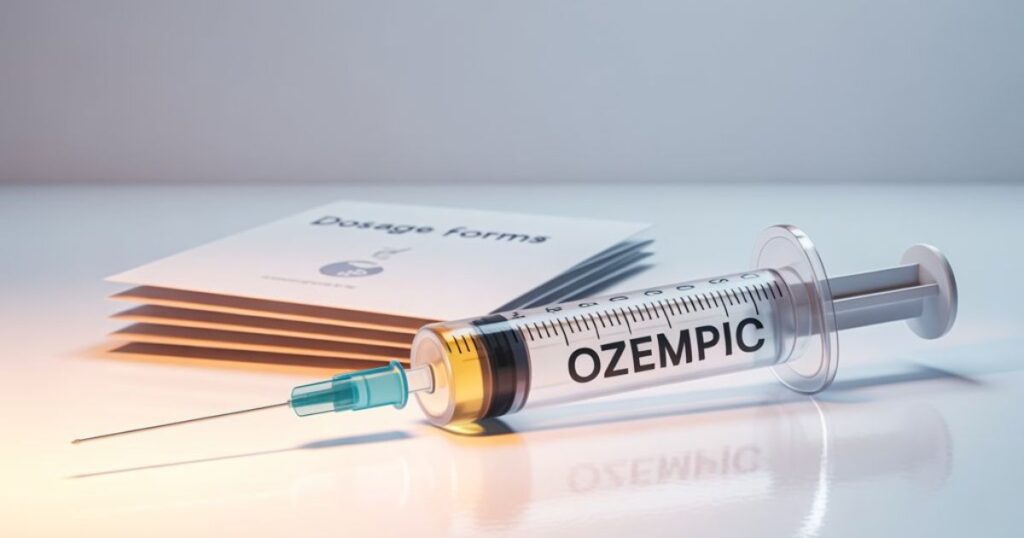Ozempic is quickly becoming a well-known name in the world of type 2 diabetes treatment, and for good reason. This FDA-approved diabetes drug doesn’t just help control blood sugar levels—it also plays a role in weight management and cardiovascular risk reduction. With its active ingredient, semaglutide, Ozempic mimics a natural hormone in the body that helps regulate insulin, glucose, and digestion. As a GLP-1 receptor agonist, it provides long-term benefits for patients looking to improve their overall health. Whether you’re managing diabetes or exploring its potential for weight loss, understanding how Ozempic works is essential. Let’s break down everything you need to know about this powerful medication.

Introduction: Why Ozempic Matters More Than Ever
Ozempic has quickly become one of the most talked-about medicines in the world of diabetes care and weight loss. It’s not just a typical drug. It helps manage blood sugar levels in people with type 2 diabetes and also offers major benefits for those struggling with obesity. In the United States, it is now often prescribed for both official and off-label use of Ozempic, including weight loss support.
What makes Ozempic truly unique is how it works in the body. As a GLP-1 receptor agonist, it mimics a natural hormone in the body, making it easier to control insulin, slow digestion, and reduce hunger. This helps with both diabetes management and healthy weight reduction.
Uses
What is Ozempic used for
Ozempic is mainly used as a type 2 diabetes treatment. It lowers blood sugar levels and helps prevent major heart problems like stroke and heart attack. It also protects the kidneys in people with chronic kidney disease. Many doctors now prescribe Ozempic to help with weight loss, although this is an off-label use of Ozempic. Patients report steady weight drop with continued use. It also reduces the risk of cardiovascular risk reduction in high-risk individuals.
How does Ozempic work (mechanism of action)
The Ozempic mechanism of action is fascinating. It works by copying a hormone that helps regulate your body’s insulin and sugar control. It boosts insulin secretion when blood sugar is high. It also slows down digestive motility, which helps you feel full longer and reduces your appetite. At the same time, it blocks the liver glucose release that usually happens between meals. This triple action helps your body in more than one way.
How is Ozempic supplied (dosage forms)
Ozempic comes in pre-filled injection pens that are easy to use. The available Ozempic dosage forms include 0.25 mg, 0.5 mg, 1 mg, and sometimes 2 mg. These doses are given once a week. The semaglutide injection frequency is the same every week, making it simple for patients to follow. Each pen is meant for Ozempic injection under the skin, usually on the stomach, thigh, or arm.

| Dose | Frequency | Form |
| 0.25mg | Weekly | Pre-filled pen |
| 0.5mg | Weekly | Pre-filled pen |
| 1mg | Weekly | Pre-filled pen |
How should I store Ozempic?
*Ozempic storage instructions* are simple. Keep new pens in the fridge between 36°F to 46°F. Once opened, you can store them at room temperature for up to 56 days. Avoid sunlight and do not freeze. For *medication safety and storage*, always keep the cap on and away from children. Follow the expiration dates closely.
Side Effects
What are the most common side effects of Ozempic
Most people feel gastrointestinal side effects in the first weeks. These include nausea, vomiting, bloating, and constipation. These symptoms often go away as your body adjusts. Still, they can be bothersome. The side effects of Ozempic are usually mild but should be monitored.
Some users also report headaches and tiredness. These may result from changing blood sugar levels. Always talk to your doctor if you experience unusual reactions or if symptoms don’t improve.
What are the serious side effects of Ozempic?
Serious issues are rare but can happen. Symptoms of pancreatitis like strong stomach pain and vomiting need urgent care. Symptoms of low blood sugar include sweating, dizziness, blurry vision, and shaking. These are more common if you take Ozempic with insulin or a sulfonylurea drug class.
One concern is Ozempic and thyroid tumors, especially a rare type called medullary thyroid carcinoma (MTC). People with a family history of Multiple Endocrine Neoplasia syndrome type 2 (MEN 2) should avoid Ozempic. Watch for swelling in the neck or hoarseness. Also, diabetes-related vision problems may get worse at first, especially in people with diabetic retinopathy.
Warnings & Precautions
Who should not use Ozempic
People allergic to semaglutide or any part of Ozempic should not take it. Also, those with a personal or family history of MTC or MEN 2 must avoid it. Allergic reactions to medications are rare but serious. Swelling, itching, or trouble breathing need immediate attention.
Women who are pregnant or breastfeeding should avoid Ozempic unless clearly needed. Ozempic during pregnancy or breastfeeding is still being studied. Your doctor can help you decide what’s safe.
What should I know about Ozempic before using it
Ozempic is a FDA-approved diabetes drug, but only when used correctly. It should not be shared. Always use a new needle each time. Drink enough water, especially if you have diarrhea or vomiting. This helps prevent a dehydration warning with Ozempic.
If you’re having surgery or dental work, tell your doctor. Ozempic slows digestion and may affect anesthesia. These are important parts of Ozempic clinical indications.
What should I tell my healthcare provider before using Ozempic
Give a full list of your medicines, including herbal supplements. This helps avoid pharmacological interactions. Talk about any past pancreatitis, kidney disease, or eye issues. You should also share your diet habits and if you’ve had trouble with low blood sugar before. This is part of personalized diabetes care.
How can I get more information about Ozempic
Ask your pharmacist for a full list of ingredients. You can also visit the official website: [https://www.ozempic.com](https://www.ozempic.com). They also offer expert help by phone. Your endocrinologist recommendation is also important in making safe choices.
Interactions
Does Ozempic interact with foods or drinks

So far, no food is known to directly affect Ozempic. But Ozempic interactions with food and alcohol are real. Alcohol may cause a drop or spike in blood sugar. Avoid heavy drinking to reduce this risk. Fatty meals can make nausea worse.
Some patients report bloating when mixing Ozempic with certain processed foods. Keeping a food journal helps track symptoms. Balanced meals improve your results.
Does Ozempic interact with other medicines (drug interactions)?
Yes, it can. Ozempic slows digestion, which means oral drugs might be absorbed slower. This may affect how well they work. Your doctor might adjust your doses. This is why Ozempic prescription guidance matters.
Take care if you use insulin or pills from the *sulfonylurea drug class. They raise the risk of **hypoglycemia symptoms* when used with Ozempic. Always carry sugar tablets just in case.
Overdose/Missed Dose
What should I do if I accidentally use too much Ozempic?
Call your doctor right away or go to the emergency room. Signs of overdose include severe nausea, vomiting, or fainting. For quick *Ozempic overdose help*, call Poison Control at 1-800-222-1222 in the U.S.
Overdosing can lead to very low blood sugar. Stay calm and get help fast. Keep a record of when and how much was used.
What should I do if I miss a dose of Ozempic?
*Missing a dose of Ozempic* is common. If it’s been under 5 days, take it as soon as you remember. If more than 5 days pass, skip it and wait for your next scheduled dose. Never take two doses close together. Doing so can cause stomach issues or *symptoms of low blood sugar*.
Look up another drug
If you’re taking other medicines, use the WebMD Drug Interaction Checker: [https://www.webmd.com/interaction-checker/default.htm](https://www.webmd.com/interaction-checker/default.htm). It helps you avoid serious *pharmacological interactions*.
Sign up for our free Good Health Newsletter
Get wellness tips to help you live happier and healthier
Join our newsletter to get weekly health updates, Ozempic guides, recipes, and more. Stay ahead in your health journey.
Follow WebMD on Social Media
Stay connected for new updates, expert talks, and lifestyle advice that complements your Ozempic journey.
Download WebMD App
Get health news, medicine trackers, and food logs with a simple mobile app. Your wellness plan just got smarter.
Ozempic for Weight Loss: Does It Work, and What Do Experts Recommend?
What is Ozempic?
Ozempic is a weight loss medication and a hormonal therapy for diabetes. It is injected once a week and helps both with sugar control and appetite reduction. Many Americans now use it beyond diabetes care for weight loss success.
How does Ozempic work?
Ozempic reduces hunger by working on the part of the brain that controls appetite. It also slows digestion, helping you feel full longer. This is why it’s part of many weight management drugs.
Does Ozempic work for weight loss purposes?
Yes, studies show that users lose 10-15% of their weight on average. It works best when paired with a healthy diet and movement. Many people share success stories in online groups.
What’s the difference between Ozempic and Wegovy?
Ozempic vs Wegovy is a hot topic. Both have the same drug, semaglutide, but Wegovy is approved for weight loss and comes in higher doses. Ozempic is mainly a diabetes drug but is often used off-label.
| Feature | Ozempic | Wegovy |
| ———— | ————– | —————– |
| Use | Diabetes | Weight Loss |
| Max Dose | 2 mg | 2.4 mg |
| FDA Approved | Yes (Diabetes) | Yes (Weight Loss) |
Are there benefits to taking Ozempic for weight loss?
It reduces cravings, improves mood, and helps form better habits. The weight loss is gradual but consistent. Blood sugar control also improves as weight drops. This dual action makes it very effective.
Is there an off-brand version of Ozempic?
Right now, there’s no generic version in the U.S. because it’s still under patent. Some online sites offer compounded versions, but they are risky and may not be safe.
Final Thoughts: Should You Try Ozempic?
If you have type 2 diabetes, obesity, or both, Ozempic might help you regain control of your health. It is powerful, but not for everyone. Work with your doctor to see if it fits your needs. With proper guidance, Ozempic could be a game-changer for your life.
Sure! Here are concise answers to each of your FAQs:
1. Ozempic side effects
Common side effects of Ozempic include nausea, vomiting, diarrhea, and constipation. Rare but serious risks include pancreatitis and thyroid tumors.
2. Ozempic weight loss
Ozempic can support weight loss by reducing appetite and slowing digestion, even though it’s primarily approved for type 2 diabetes.
3. Ozempic tablets
Ozempic is currently available only as an injectable; there is no tablet form of Ozempic approved for use.
4. Ozempic injection price
The price of Ozempic can range from $850 to $1,200 per month in the U.S. without insurance, depending on the pharmacy.
Meta description


